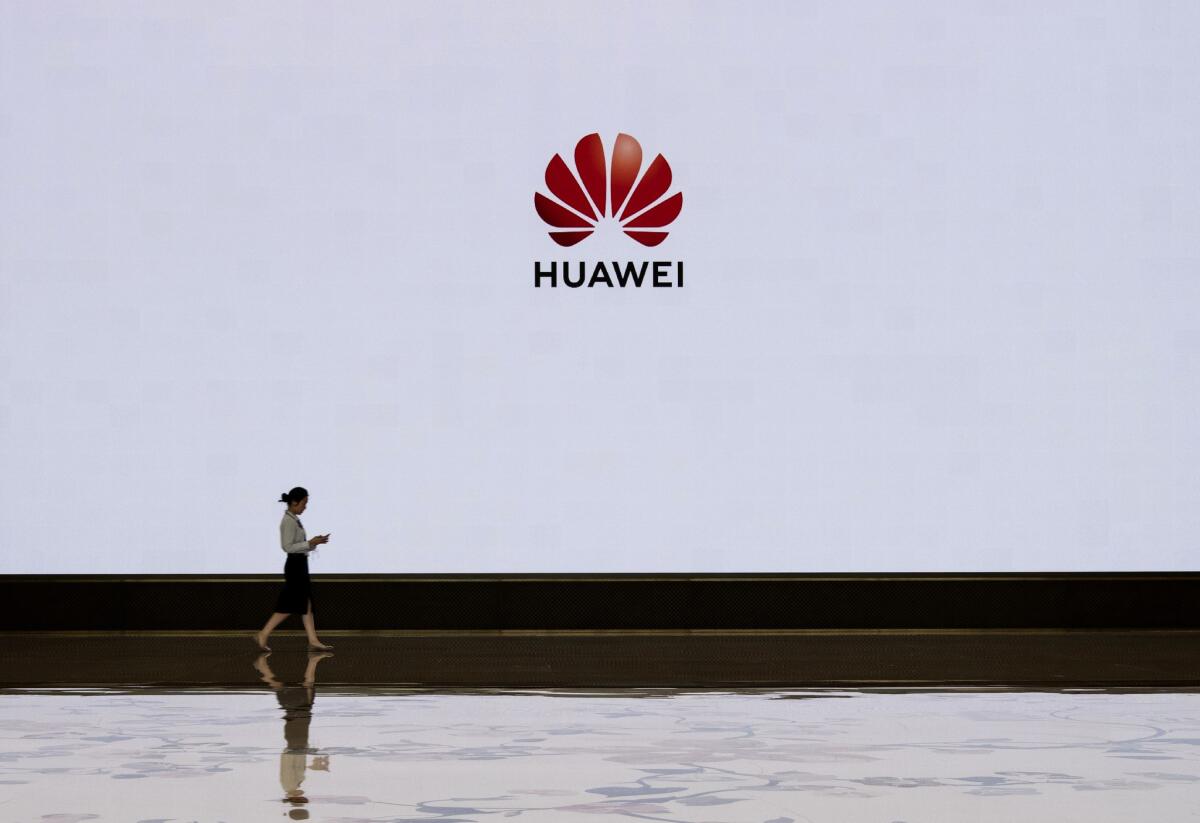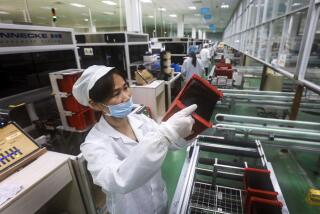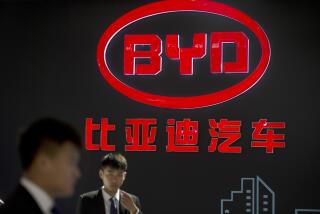Will Huawei’s loss be Samsung’s gain in the China-U.S. trade war?

Reporting from Seoul — The giant digital billboard advertising a swanky new smartphone loomed directly above a Samsung kiosk in a shopping mall in Brisbane, Australia, towering twice as tall as the store.
But the Mother’s Day ad wasn’t advertising Samsung’s new flagship Galaxy S10. It was plugging its main rival, the Huawei P30.
While Apple and Samsung have been locked in a tussle for the smartphone market in the U.S. for years, elsewhere in the world the competition has increasingly come down to Samsung and Huawei.
With rapidly advancing features, aggressive marketing and competitive prices, Huawei has meteorically risen in recent years to overtake Apple for second place in global smartphone sales. This year, it was poised to begin nipping at Samsung’s heels, with a Huawei executive pledging to surpass Samsung by year’s end.
That is, before President Trump’s Huawei ban.
Executive orders signed by Trump cutting Huawei off from American-made software and parts from U.S. suppliers threaten to cripple Huawei’s supply chain and dramatically undercut Huawei’s recent popularity in markets outside China. The U.S. alleges the Shenzhen-headquartered company is a national security threat because it has close ties to the Chinese government, which Huawei has denied.
The ban has raised concerns that China may retaliate by imposing similar measures barring Chinese companies from selling to or buying from American tech companies including Apple.
Left standing as the unintended beneficiary may be South Korean tech behemoth Samsung.
“Samsung is ideally positioned. Samsung has a lot to gain,” said Harish Jonnalagadda, Asia editor of the tech enthusiast website Android Central, who is based in India. “In the short term, the U.S. government might have done Samsung a favor by issuing this ban.”
News of the U.S.’s blacklisting of Huawei couldn’t have come at a more opportune time for Samsung. In 2018, Huawei increased its global smartphone sales by 50% while Samsung’s volume shrank by 8%. In the first quarter of 2019, Huawei sold 19% of the world’s smartphone devices compared with Samsung’s 23% — a dramatic increase from its 12% share just a year ago, according to market research firm IDC.
The rivalry features two companies with similarly humble origin stories and near-mythic tales of growth and success in their respective countries.
Samsung began as a trading company in 1938 and entered the electronics business in the 1960s, becoming a dominant player over the decades by vertically integrating its supply chain and building up engineering expertise and marketing savvy. Still controlled by the family of founder Lee Byung-chul and with 2018 revenue from its electronics arm alone topping $200 billion — the company also makes apparel, medical equipment and ships — Samsung is the largest of South Korea’s chaebol conglomerates.
Samsung, with its larger displays and competitive prices, established itself as the Android-based alternative to iPhone around 2012, fighting drawn-out battles with Apple not only in stores but also in patent disputes and marketing campaigns.
Huawei founder Ren Zhengfei started his company in 1987 as a peddler of telephone switch equipment sourced from Hong Kong and built it into a giant that last year topped $100 billion in revenue — a rise the U.S. contends was helped by cozy ties with the Chinese government.
Fueled by China’s rapidly growing demand for smartphones, Huawei invested heavily in research and development. It came up with what is considered the best smartphone camera available to date, partnering with the storied German camera maker Leica, and aggressively marketed that feature, said Nicole Peng, a Hong Kong-based global mobile industry analyst with tech market analysis firm Canalys.
“This grabbed people’s attention,” she said. “Previously, people were thinking this is a brand I cannot pronounce, it’s Chinese, maybe it’s cheap.”
But it’s an open question whether Huawei can hold its ground outside China without Google’s popular Android operating system — widely established among and familiar to consumers around the world — and access to the myriad apps on Google Play. Fitch Ratings said this week that Huawei would probably give back ground to Samsung in markets where it had been rapidly taking over — in South America, Europe and Asia.
Huawei had been gaining enough confidence to take on Samsung directly. Whereas previously Huawei would stagger its phone launches to be months apart from Samsung’s major releases, recently it began releasing them at virtually the same time to compete head-to-head, Peng said.
In February, the companies unveiled pricey, revolutionary phones with foldable screens within days of each other. Although Samsung beat Huawei to the punch, its Galaxy Fold was soon beset by quality issues as users reported the screens on brand-new phones were breaking.
“In the past, they fell maybe six months, one year behind” Samsung in research and development, Peng said. The dueling foldable-phone launch, she said, “is putting them at not exactly the same level as Samsung but almost.”
Samsung and Huawei are also competing for shares of the 5G network equipment market as countries are gearing up to roll out next-generation telecom infrastructure.
Any sanguinity about a potential boost to Samsung’s business from a Huawei ban was tempered, though, by concern in Seoul that Samsung and other South Korean companies could soon get swept up in the U.S.-China trade standoff.
Chosun Ilbo, one of South Korea’s main daily newspapers, cited anonymous government officials as saying representatives of the U.S. State Department had requested that South Korea also freeze Huawei out of its network infrastructure.
The newspaper said South Korea siding with the U.S. could leave the nation “stuck between the U.S. and China” — unable to refuse U.S. requests but facing potential retribution from China, by far its biggest trading partner. LG Uplus, a South Korean wireless carrier, uses Huawei equipment in its 5G network.
“The U.S. is going to be putting pressure on South Korea to go along with it, and if Korea joins, there’s the risk China will retaliate in various ways,” said C.W. Chung, an analyst with Nomura Securities in Seoul.
Chung also noted Samsung could be hurt if Huawei’s troubles lead to a general downturn in smartphone sales. It manufactures chips used in devices and Huawei is one of its main customers. If weak sales lead to a 1% price decline in chips, the loss in that part of its business would more than offset any revenue boost from selling more of its own smartphones, Chung said.
“The uncertainty will impact the global market,” he said.
Trump last week said the administration’s chokehold on Huawei could be negotiated away as part of the trade deal with China. But even if the ban were lifted, the damage to consumers’ perceptions from the ordeal may be permanent, analysts said.
“There’s going to be a lot of mistrust in the brand, negativity on what Huawei is as an entity,” said Jonnalagadda of Android Central. “It’s going to hurt Huawei’s sales.”
More to Read
Sign up for Essential California
The most important California stories and recommendations in your inbox every morning.
You may occasionally receive promotional content from the Los Angeles Times.










